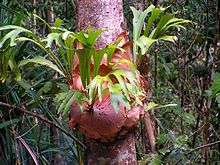Platycerium bifurcatum
Platycerium bifurcatum, the elkhorn fern or common staghorn fern,[1] is a species of fern native to Java, New Guinea and eastern Australia, in New South Wales, Queensland and on Lord Howe Island. It is a bracket epiphyte occurring in and near rainforests. Growing to 90 cm (35 in) tall by 80 cm (31 in) broad, it has heart-shaped sterile fronds 12–45 cm (5–18 in) long, and arching grey-green fertile fronds which are forked and strap-shaped, and grow up to 90 cm (35 in) long.[1]
| Platycerium bifurcatum | |
|---|---|
 | |
| P. bifurcatum, Kuranda, Queensland, Australia | |
| Scientific classification | |
| Kingdom: | Plantae |
| Clade: | Tracheophytes |
| Class: | Polypodiopsida |
| Order: | Polypodiales |
| Suborder: | Polypodiineae |
| Family: | Polypodiaceae |
| Genus: | Platycerium |
| Species: | P. bifurcatum |
| Binomial name | |
| Platycerium bifurcatum | |
The specific epithet bifurcatum means bifurcated or forked, referring to the fertile fronds.[2]
Platycerium bifurcatum is cultivated as an ornamental plant for gardens. With a minimum temperature requirement of 5 °C (41 °F), in temperate regions it may be grown outdoors in sheltered locations, otherwise as a houseplant.[1] It has gained the Royal Horticultural Society's Award of Garden Merit.[3][4]
References
- RHS A-Z encyclopedia of garden plants. United Kingdom: Dorling Kindersley. 2008. p. 1136. ISBN 1405332964.
- http://www.anbg.gov.au/gnp/interns-2004/platycerium-bifurcatum.html
- "RHS Plant Selector - Platycerium bifurcatum". Retrieved 27 May 2013.
- "AGM Plants - Ornamental" (PDF). Royal Horticultural Society. July 2017. p. 79. Retrieved 2 May 2018.
| Wikimedia Commons has media related to Platycerium bifurcatum. |
- NSW Flora Online http://plantnet.rbgsyd.nsw.gov.au/cgi-bin/NSWfl.pl?page=nswfl&lvl=sp&name=Platycerium~bifurcatum retrieved 3 September 2009